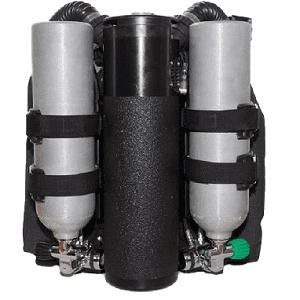Home › Scuba Diving Activities › Dive Equipment List › Rebreathers
Rebreathers Explained for Beginners
Are you a diver looking to improve your gas efficiency and experience longer dive times? If so, that's exactly where a rebreather system can help you.
This guide explains the basics about rebreathers, including why they're becoming more popular, how they function, and how the features differ to those used in open-circuit scuba diving.
How Does the Rebreather Work in Diving?
To keep it simple, removing carbon dioxide and replacing oxygen used by the diver are the two main functions of a rebreather.
The system achieves these twin processes by circulating the breathing gas. So, the diver will be rebreathing the gas instead of exhaling it into the water via the scuba regulator.
Hence the longer dive times.
So, a basic rebreather system reuses the exhaled gas. Then, it recycles the usable part (oxygen) and replenishes it for the diver to breathe.
This is why gas supply will be significantly more in a compact package. Otherwise, it would be limited by the same constraints for storing compressed air in a typical 12 litre dive bottle - such as in open-circuit scuba diving.
3 Benefits of Rebreather Diving
- Recycling the oxygen content means divers can continue breathing from a rebreather system for longer to get enhanced bottom times.
- Using a breathing apparatus that can absorb carbon dioxide removes the need to exhale "noisy bubbles" into the water through the regulator second stage. Thus, divers can get closer to more aquatic creatures (ideal for taking underwater photos).
- The gas recycling process adds a certain amount of warmth to the breathing gas. So, diving with a rebreather can keep the diver warmer (a huge bonus when drysuit diving in cool water).
Common Types of Rebreathers
Closed-Circuit Rebreather (CCR)
CCRs can recycle all the gas that a diver exhales. Plus, there will only be a few tiny bubbles escaping from the unit as the diver ascends (to release expanding gas).
You need to have two (2) gas supplies to operate a closed circuit rebreather. In most cases, you will be using air as a diluent gas and 100% oxygen.
Semi-Closed Rebreather (SCR)
Using a semi-closed circuit means you will only be recycling some of the exhaled gas. In other words, there will be a steady stream of bubbles (or short bursts) escaping - away from your face.
Semi-closed circuit rebreathers only need to have one (1) gas supply. In most cases, the breathing gas should be enriched air nitrox.
You can also achieve some of the benefits of nitrox diving by using the standard mix of EANx36 (sometimes higher concentrations).
Key Components of Rebreathers
- Counterlung
- This airtight bag (or one each side of the scrubber) is made from strong flexible material to hold the exhaled gas. The bag expands when the diver exhales, and then it contracts upon inhalation.
- Valves
- Non-return valves control the flow of gas as part of the breathing volume, as well as the gas feed from the storage container. The process operates through a chemical scrubber and a breathing hose assembly to remove exhaled, waste carbon dioxide (CO2).
- Mouthpiece
- The mouthpiece (or facemask) allows the diver to breathe 'hands-free' from the unit. It also connects to a bailout valve (BOV) for emergencies. This is an open-circuit second stage regulator attached to a cylinder that contains a breathing gas.
- Gas supply
- The main purpose of this feature is to provide a supply into the gas flow loop to replenish the consumed oxygen. It also increases the counterlung volume as and when it's required.
- Oxygen sensor
- This electronic module monitors the partial pressure of oxygen (pO2) in mixed gas rebreathers. It's very important to make sure that it stays inside the safe limits.
Nowadays, the Type R rebreathers (which stands for recreational), are becoming more popular for "no-stop" diving (e.g. removing the likelihood of omitted or interrupted decompression stops during the ascent).
Some of the typical characteristics of a Type R rebreather will be:
 The use of pre-packed scrubber canisters so there is no need to mix the chemicals.
The use of pre-packed scrubber canisters so there is no need to mix the chemicals.- Inoperable unit if the canister is missing (or it will alert the diver).
- Electronic prompts for carrying out the pre dive check.
- Automatic set point controller to maintain the partial pressure of oxygen at the chosen setpoint.
- Scrubber duration estimation facility.
- Warnings for low (or closed) gas supply, high or low pO2, and low battery life.
- Use of a black-box data recording function as part of the electronics.
- A display warning system in the line-of-sight during normal diving.
PADI® Rebreather Courses
One of the main benefits of using Type R rebreather units is to introduce divers to rebreather diving while staying inside the limitations for recreational dives and various scuba programs.
In general, they are easy to use and the electronically controlled backup facility simplifies the training. The most popular courses include:
- Discover Technical Diving
- Nitrox Scuba Certification (EANx)
- Rebreather Diver
- Advanced Rebreather Diver Specialty
Pro Tip: There are several Tec Closed Circuit Rebreather (CCR) courses that allow technical divers to go beyond recreational dive limits when using a Type T CCR.
Rebreather Set Up and Maintenance
Always read through the manufacturer's documentation before you go diving with any new rebreather. Be mindful that different models will have variances for setup and post dive procedures
You will reference the manufacturer's literature and learn how to set up a rebreather in the training sessions. Even so, always keep the instruction booklet handy each time you dive (e.g. for double checking the data).
Important: Only a manufacturer-authorised technician can conduct rebreather servicing. In most cases, they will need to carry out a service at least once a year. Remember, keep accurate records of all service and maintenance work done on your rebreather.